The Predators Prospect Report is a monthly article in which I write about the state of the Nashville Predators farm system and how individual prospects are performing. I consider a player to be a prospect if he is younger than 25 and has accumulated fewer than 50 NHL games.
Related: March’s Prospect Report
April’s Prospect Report is a little bit different. The Predators’ season has concluded, the Milwaukee Admirals’ season is over, as is the college hockey season. In fact, none of the Predators’ prospects are still playing hockey this season. Therefore, April’s Prospect Report will be the final one until the draft in June. This report will also be different because I’m going to focus more on the team’s younger prospects. This means going away from prospects who are unlikely to advance beyond the AHL and instead discussing prospects who have more potential.
Top-10 Predators Prospects for April
1. F Eeli Tolvanen, Milwaukee Admirals (March Rank: 1)
- Draft Information: 2017 1st Round (30th Overall)
- Season Stats: 58 games played (GP), 15 goals (G), 20 assists (A), 156 shots on goal (SOG), 4 power play goals (PPG), 25 primary points (P1)
- April Stats: 6 GP, 1 G, 5 A, 13 SOG, 1 PPG (Regular Season); 5 GP, 0 G, 0 A, 4 SOG (Playoffs)
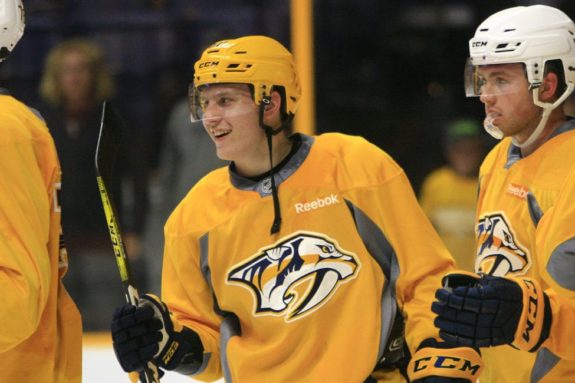
The Predators’ top prospect played a big role in the Admirals not losing a game in regulation in April and getting into the postseason. Tolvanen had six points, with his only goal occurring on the power play and he had a shot on goal in all six games. In five playoff games, Tolvanen failed to register a point and was a minus-four. Had the Admirals not made the playoffs, there’s a strong chance he would have been one of the extra skaters carried by the Predators in the Stanley Cup Playoffs. How he develops over the offseason will go a long way in him nailing down an NHL roster spot in 2019-20. He’ll also be a candidate to represent Finland at the upcoming World Championships, although the nation had yet to reveal its roster at the time of writing this.
2. D Dante Fabbro, Nashville Predators (March Rank: 2)
- Draft Information: 2016 1st Round (17th Overall)
- Season Stats: 4 GP, 1 G, 0 A, 5 SOG, 1 P1 (NHL); 38 GP, 7 G, 26 A, 5 PPG, 108 SOG (NCAA)
- April Stats: 3 GP, 1 G, 0 A, 2 SOG (Regular Season); 6 GP, 0 G, 1 A, 3 SOG (Playoffs)
Upon signing his entry-level contract (ELC), all that Fabbro has done is slot in on the Predators’ third defense pair and look comfortable doing so. He played sheltered minutes and averaged just 12:44 of ice time in four regular-season games. Being partnered with Dan Hamhuis also helped Fabbro settle in as Hamhuis is a safe, responsible defenseman.
This resulted in Fabbro playing his game: excelling on the breakout, making the correct passes and occasionally pinching in the offensive zone. In the postseason, he again looked at home, with one assist in six games while averaging 12:05. He was also a plus-two. With how well Fabbro played, he will quickly play himself above a third-pair role and the Predators will need to make room for him in the top-four. On April 29, it was announced that he’d be joining Team Canada at the 2019 World Championships in Slovakia.
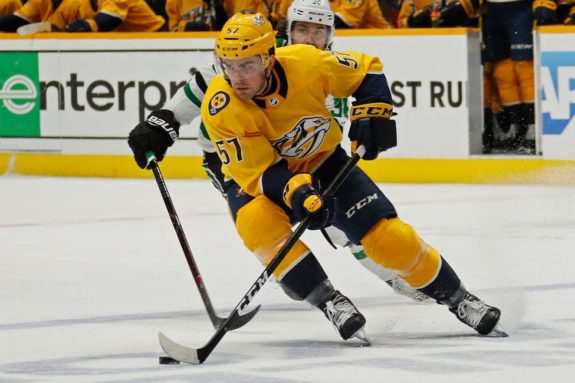
3. F Rem Pitlick, Nashville Predators (March Rank: 3)
- Draft Information: 2016 3rd Round (76th Overall)
- Season Stats: 1 GP, 0 G, 0 A, 0 SOG (NHL); 38 GP, 21 G, 24 A, 10 PPG, 124 SOG (NCAA)
- April Stats: No Stats
After signing his own ELC once the University of Minnesota’s season ended, Pitlick played in one NHL game and went pointless. That was the only game he played after signing his contract as he was never sent to the AHL. I’m uncertain why they didn’t send him down considering the team was already burning a year of his ELC by playing him in an NHL game. Perhaps the front office wanted him around the NHL squad and didn’t want to mess up the Admirals’ chemistry? Either way, Pitlick looked pretty good in his NHL debut, but he’s almost certainly going to start 2019-20 in the AHL.
4. D Alexandre Carrier, Milwaukee Admirals (March Rank: 5)
- Draft Information: 2015 4th Round (115th Overall)
- Season Stats: 76 GP, 5 G, 32 A, 1 PPG, 106 SOG, 22 P1
- April Stats: 6 GP, 1 G, 4 A, 2 SOG (Regular Season); 5 GP, 0 G, 0 A, 8 SOG (Playoffs)
Behind Fabbro, it’s a toss-up between Carrier and Frédéric Allard for who’s the Predators’ second-best defense prospect. At 22, Carrier is a year older than Allard and is also the more polished prospect. He finished the season as the Admirals’ highest-scoring defenseman and has bounced back after a down 2017-18 season. He could be on the verge of being one of the extra defensemen carried by the Predators next season, but both Matt Irwin and Yannick Weber are signed through 2019-20. If one of the team’s current top-four is moved this summer, perhaps there will be a spot for Carrier.
5. D Frédéric Allard, Milwaukee Admirals (March Rank: 6)
- Draft Information: 2016 3rd Round (78th Overall)
- Season Stats: 65 GP, 4 G, 29 P, 1 PPG, 119 SOG, 16 P1
- April Stats: 4 GP, 0 G, 2 A, 2 SOG (Regular Season); 5 GP, 1 G, 1 A, 11 SOG (Playoffs)
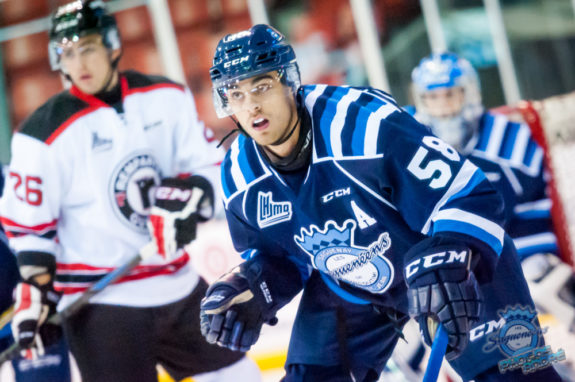
Allard finished the regular season on a good roll and he was even better in the postseason with two points in four games. Both of his points occurred in the Admirals’ Game 4 win, including netting the game-winning goal. Although inconsistent, he had a pretty good second AHL season. It’d be nice to see him get better at getting shots through traffic, but that should be something that comes with maturation. Keep in mind, Allard only turned 21 in December, so he’s more than a full year younger than Carrier. I see Allard’s development as one year behind Carrier and he could be an extra defenseman in the NHL in two seasons, assuming he isn’t surpassed by another prospect.
6. F Anthony Richard, Milwaukee Admirals (March Rank: 7)
- Draft Information: 2015 4th Round (100th Overall)
- Season Stats: 73 GP, 24 G, 23 A, 6 PPG, 153 SOG, 38 P1
- April Stats: 6 GP, 2 G, 1 A, 1 PPG, 17 SOG (Regular Season); 5 GP, 4 G, 1 A, 14 SOG (Playoffs)
Of players who were Admirals from the start of the season, Richard led the team with 47 points. He is clearly a playmaker with 38 of his 47 points being primary. This skillset led to the Predators recalling him earlier this season and he got a game in the NHL as a result. He finished the season with three points in six regular-season games and has followed that up with four points in four AHL Playoff games. Three of his four points occurred in the Admirals’ two wins that evened up their series with the Iowa Wild. One of his two goals in the Admirals’ Game 4 victory was even shorthanded.
7. F Yakov Trenin, Milwaukee Admirals (March Rank: 8)
- Draft Information: 2015 2nd Round (55th Overall)
- Season Stats: 74 GP, 14 G, 19 A, 2 PPG, 114 SOG, 28 P1
- April Stats: 6 GP, 2 G 1 A, 14 SOG (Regular Season); 5 GP, 0 G, 3 A, 6 SOG (Playoffs)
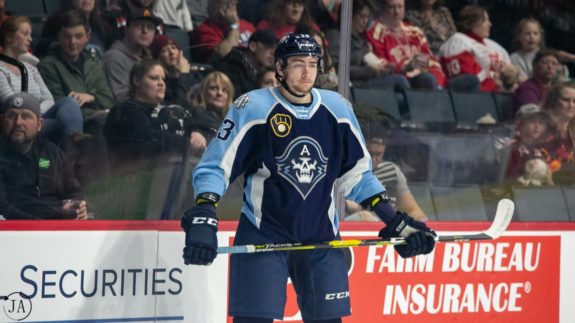
In his second full AHL season, Trenin increased his production by a sizable amount – .36 points-per-game (P/G) in 2017-18 versus .43 in 2018-19. But in addition to displaying his offensive talent, he’s also a solid two-way forward. He finished the regular season with three points in six games and had three assists in four playoff games. All three assists occurred in the Admirals’ Game 3 win. Signed through 2019-20, Trenin will look to play a bigger role next season.
8. F Jáchym Kondelík, University of Connecticut (March Rank: 9)
- Draft Information: 2018 4th Round (111th Overall)
- Season Stats: 33 GP, 4 G, 22 A, 66 SOG
- April Stats: No Stats
The University of Connecticut’s season ended in early March and the Huskies weren’t a good team in 2018-19. One of their bright spots was Kondelík, the Predators’ 2018 fourth-round pick. The hulking 6-foot-7 center finished his freshman season with a .79 P/G average, and he was also quite good defensively. Already with NHL size, after another season or two of college hockey, expect the Predators to attempt to sign him.
9. G Niclas Westerholm, Milwaukee Admirals (March Rank: Unranked)
- Draft Information: Undrafted
- Season Stats: 15 GP, 5-6-1, 2 shutouts (SO), 2.27 goals-against average (GAA), .907 save percentage (SV%) (Liiga); 2 GP, 2.00 GAA, .940 SV% (Mestis)
- April Stats: No Stats
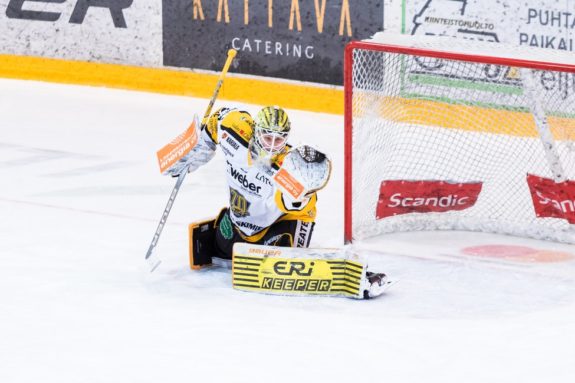
Finnish netminder Niclas Westerholm is an interesting prospect for the Predators. Going undrafted, the Predators signed him as a free agent in April 2018 after his first professional hockey season in Finland. A late bloomer, Westerholm worked his way through Finland’s hockey system, eventually reaching the nation’s top league, Liiga, in 2017-18. At 6-foot-4, he isn’t a giant, but he has drawn comparisons to Pekka Rinne, another Finnish netminder.
Related: Westerholm Drawing Comparisons to Rinne
This season, he split time between the Liiga and the Mestis, Finland’s second-tier league, making 17 total appearances. With SaiPa of the Liiga, Westerholm served in a backup capacity to Frans Tuohimaa and Westerholm often received the team’s most difficult starts. Despite this, and playing behind a porous defense, he posted the team’s best goaltending stats. After his season ended in Finland, the Predators recalled him and he joined the NHL club during their playoff series as their third goaltender. He never saw any game action.
What happens with Westerholm in 2019-20 will be interesting. He could join the Admirals and back-up or split starts with Troy Grosenick. He could also return to SaiPa and be their starter with Tuohimaa a free agent this summer. Whatever provides him with the best opportunity to play is the most ideal situation as he’s never made more than 29 appearances in a season. At 21, he’s still raw, but he’s shown enough for the Predators to take a serious interest in him. Besides, they’ve had plenty of success with Finnish goaltenders whose stats didn’t set the world on fire early in their careers (see Rinne). Right now, Westerholm is fairly obviously the Predators’ top goaltending prospect.
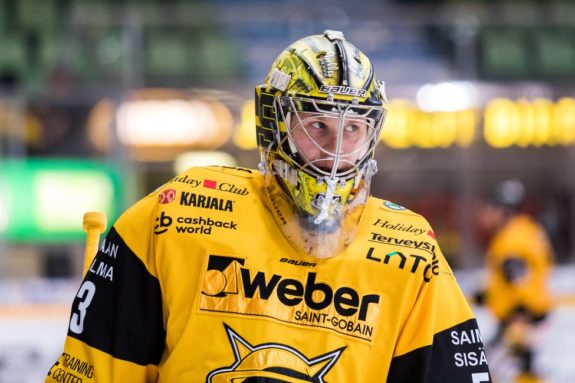
10. F Patrick Harper, Boston University (March Rank: 10)
- Draft Information: 2016 5th Round (138th Overall)
- Season Stats: 38 GP, 6 G, 14 A, 50 SOG
- April Stats: No Stats
I’ve written on several occasions about Harper’s 2018-19 season, but for a brief recap: it started out poor, likely the result of lingering effects from the mysterious illness that cut short his 2017-18 season, but ended on a stronger note. He finished with 20 points in 38 games, his fewest point total of his three seasons at Boston University. Next season will be his senior campaign and it’s time for him to convince the Predators they should take a shot on him.
He still has the skills that resulted in 37 points in 38 games as a freshman, he just needs to put it all together. He’ll take on a bigger role in 2019-20 than he did in 2018-19 after many of their top players left for the NHL or graduated. In fact, of returning Terriers, Harper’s 20 points are second among forwards. B.U. recruits well, but this is a program in transition and it could mean a second consecutive season of mediocre results. This is good and bad for a player like Harper. The good: he’ll have plenty of opportunity to shine, including on the power play. The bad: there won’t be as much talent around him.
Outside Top-10, But Knocking on the Door
D David Farrance, Boston University (March Rank: Unranked)
- Draft Information: 2017 3rd Round (92nd Overall)
- Season Stats: 37 GP, 4 G, 16 A, 2 PPG, 64 SOG
- April Stats: No Stats
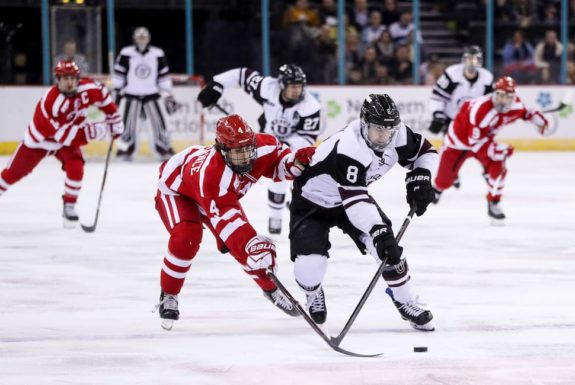
Like Harper, much has been written about Farrance’s season. He just wrapped up his sophomore season at B.U. and more than doubled the nine points he had as a freshman. He spent much of 2018-19 on a defense pair with Fabbro and it greatly helped Farrance. Also like Harper, Farrance will be given a great opportunity in 2019-20. Of returning Terriers, he’s the highest-scoring blueliner and will be the position’s anchor. An increase in playing time and responsibility could be what Farrance needs to take the next step in his development.
G Tomas Vomacka, University of Connecticut (March Rank: Unranked)
- Draft Information: 2017 5th Round (154th Overall)
- Season Stats: 15 GP, 7-7-0, 1 SO, 2.32 GAA, .922 SV%
- April Stats: No Stats
The 2018-19 season was Vomacka’s freshman season at UConn. He appeared in 15 games and served in a backup role to New York Rangers prospect Adam Huska. Despite being the backup, Vomacka had the better stats and his .922 SV% ranked 16th in the country despite playing on a poor Huskies team. He ended the season by being named to Hockey East’s All-Rookie Team. Next season, he’ll have the inside track to be UConn’s starter as Huska signed his ELC with the Rangers and finished 2018-19 in the AHL. Westerholm may be the Predators’ most promising goaltending prospect, but Vomacka is an intriguing option.
Other Prospect Notes
- The Predators signed three college free agents since the last Prospect Report. They signed left winger Lukas Craggs out of Bowling Green State, center Josh Wilkins from Providence and defenseman Brandon Fortunato from Quinnipiac. All three are likely to be in the AHL next season.
- After 2015 third-round pick Tommy Novak signed a tryout contract in March, he appeared in three games with the Admirals, posting one assist. He also played in one playoff game, going pointless. Now perhaps the Predators didn’t sign him to an ELC so as to not burn the first year and instead will sign him this summer, but it seems there’s a possibility they release him this offseason and he becomes a free agent.
- On April 4, the Predators signed another of their prospects, defenseman Adam Smith. The 2016 seventh-rounder just wrapped up his senior season with Bowling Green State and joined the ECHL’s Atlanta Gladiators for one game. He too should be in the AHL next season. (from ‘Sharon Resident Adam Smith Signs with NHL Predators’ Organization’ – York Region – 4/6/19)
State of the Predators’ Farm System
As a team in the winning portion of the success cycle, the Predators don’t have a high-end farm system. Their top prospect, Tolvanen, is in the AHL and should be in the NHL in 2019-20, and Fabbro, their second-best prospect, is already in the NHL. They have some other talent in the AHL, but most of their AHLers feel like 13th forwards or seventh defensemen in the NHL at-best. They do have some intriguing prospects at the college level and in the CHL, but they’re projects and are a long way away. Still possessing seven draft picks, including their first-rounder, at the 2019 Entry Draft, general manager David Poile needs to focus on replenishing the farm system, especially on the blue line.